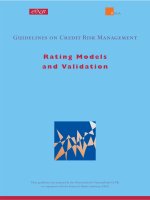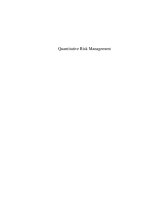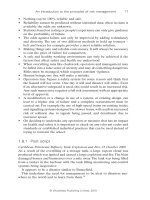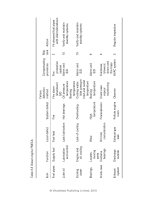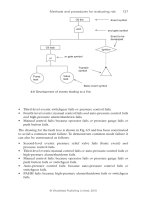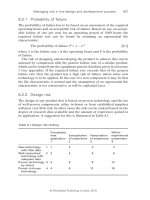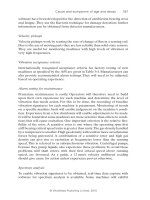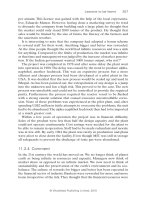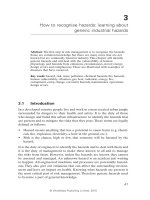Schweser QBank 2017derivatives 02 risk management applicatio rd and futures strategies
Bạn đang xem bản rút gọn của tài liệu. Xem và tải ngay bản đầy đủ của tài liệu tại đây (185.92 KB, 22 trang )
Risk Management Applications of Forward and Futures Strategies
Test ID: 7428275
Question #1 of 55
Question ID: 466512
Redden Capital Management manages an intermediate, high-quality bond portfolio with a value of $12 million dollars. The
modified duration of the portfolio is 4.4 years with a yield beta of 1.0. Scott Stuart, the manager of the portfolio is concerned
about rising interest rates over the next few months and wants to make a tactical adjustment and cut the duration of the
portfolio in half. Stuart asks Amy Swemba, a junior portfolio manager with Redden, to accomplish this task. Swemba is aware
that a Treasury bond futures contract exists with a value of $102,000, with a modified duration of 8.2 years. Swemba replies to
Stuart's comments with the following statements:
Statement 1:
The fastest and most cost-effective way to reduce the duration of the portfolio by half would be to sell
$6 million dollars worth of the actual bonds in the portfolio.
Statement 2:
The portfolio's duration could also be adjusted by selling 40 of the Treasury bond futures contracts.
After listening to Swemba's statements, Stuart should:
ᅚ A) disagree with both Statement 1 and Statement 2.
ᅞ B) agree with Statement 1, but disagree with Statement 2.
ᅞ C) disagree with Statement 1, but agree with Statement 2.
Explanation
NOTE - on the exam, it is very likely for material on tactical asset allocation to be tested in conjunction with material from
derivatives as tactical asset allocation can be accomplished by selling assets, or with a derivative overlay. Stuart should
disagree with both of Swemba's statements. Although Stuart's goal of reducing the duration could be accomplished by selling
bonds in the portfolio, doing so would likely incur significant transaction costs. Also, since the duration of each bond in the
portfolio is likely different, specific bonds would have to be selected in order to accomplish Stuart's goal, making the process
more difficult. A derivative overlay, accomplished by using futures contracts, would be much easier and cost effective. Swemba
is also incorrect with respect to the number of futures contracts that would need to be sold. The correct number of futures
contracts to be sold is: (1.0)[(2.2 - 4.4) / 8.2]($12,000,000 / $102,000) = -31.56 ≈ -32 futures contracts. The minus sign means
that 32 contracts should be sold to achieve the desired duration in the portfolio.
Question #2 of 55
Question ID: 466518
A portfolio manager knows that a $10 million inflow of cash will be received in a month. The portfolio under management is
70% invested in stock with an average beta of 0.8 and 30% invested in bonds with a duration of 5. The most appropriate stock
index futures contract has a price of $233,450 and a beta of 1.1. The most appropriate bond index futures has a duration of 6
and a price of $99,500. How can the manager pre-invest the $10 million in the appropriate proportions? Take a:
ᅞ A) long position in 25 of the stock futures and 28 of the bond futures.
ᅞ B) short position in 25 of the bond futures and 22 of the stock futures.
ᅚ C) long position in 22 of the stock futures and 25 of the bond futures.
Explanation
The goal is to create a $7 million equity position with a beta of 0.8 and a $3 million bond position with a duration of 5:
number of stock futures = 21.8 = (0.8 − 0) × ($7,000,000) / (1.1 × $233,450)
number of bond futures = 25.13 = (5 − 0) × ($3,000,000) / (6 × $99,500)
The manager should take a long position in 22 of the stock index futures and 25 of the bond index futures.
Questions #3-8 of 55
George Kaufman, portfolio manager and CEO of Kaufman Co., is extremely busy. He has a number of important issues that
must be dealt with before the end of the week.
The portfolio Kaufman manages consists of $40 million in bonds and $60 million in equities. The modified duration of the bond
portfolio is 6.3. The beta of the equity portfolio is 1.25. The holding period for each is 1 year. Kaufman also has the authority to
borrow up to $25 million which may be invested on a short-term basis to earn the spread between the borrowing rate and the
investing rate.
Kaufman is afraid that interest rates will rise 25 basis points in the near future and would like to decrease the duration of the
bond portion of the portfolio to 5.0 for a short period of time. He prefers to use futures contracts to do this since it is a
temporary change and he does not want to actually sell bonds in the portfolio. Kaufman is considering using a Treasury bond
futures contract that has a modified duration of 4.2, a yield beta of 1.1, and a price (including the multiplier) of $245,000.
Kaufman would like to borrow money three months from today so he can invest at the expected higher interest rates.
However, he would like to lock in today's interest rates for the loan. To do this he is considering locking in a loan rate using a
forward rate agreement (FRA). A cash settlement will be made based on the actual interest rate three months from now,
relative to the FRA interest rate. If Kaufman decides on this strategy, he would borrow $20 million at 5 percent for 9 months.
The loan date would start three months from today.
The equity portion of the portfolio has performed extremely well over the recent past and Kaufman must decide on one of the
following two strategies:
Equity Strategy 1: Kaufman could hold on to his current profits for the next six months which should make the reported annual
return rank in the top one percentile of similar portfolios. Again, Kaufman prefers to use futures contracts instead of selling
stocks to lock in the profits. The portfolio is composed of the same stocks and sector weightings as the S&P 500. The contract
on the index is at 2000 (with a multiplier of 250), and it expires in 6 months. The risk free rate is 2 percent and the dividend
yield on the index is 3 percent.
Equity Strategy 2: Kaufman believes there is a chance the market may move significantly over the next six months. To benefit
from the expected move in the market, Kaufman could increase the equity portion of the portfolio from its current beta of 1.25
to 1.4 by using equity index futures. The appropriate equity index futures contract that Kaufman is considering using has a
beta of 0.90 and a price (including the multiplier) of $335,000.
Finally, Kaufman Co. is expecting a $6 million cash inflow in 4 months and would like to pre-invest the funds to create the
same exposure to the bond and stock market that is found in the original portfolio. The most appropriate stock index futures
contract for accomplishing this has a total price (including the multiplier) of $315,650 and a beta of 1.10. The most appropriate
bond index futures contract has a total price of $115,460, a yield beta of 1.05 and an effective duration of 6.2.
Question #3 of 55
Question ID: 466492
Assume Kaufman Co. uses a FRA to hedge the loan rate. If interest rates are 4.85 percent at expiration of the FRA, the
settlement payment is closest to:
ᅚ A) $21,710, with Kaufman paying the bank the settlement.
ᅞ B) $21,710, with the bank paying Kaufman the settlement.
ᅞ C) $28,739, with Kaufman paying the bank the settlement.
Explanation
Settlement
payment
= 20,000,000 × [(0.0485 − 0.05) × (270 / 360)] / [1 + ((0.0485)(270 / 360)]
= 20,000,000 × (−0.001125 / 1.036375) = $21,710.29
Since the realized rate at the time of the loan, 4.85%, is lower than the contract rate of 5%, Kaufman would want to pay to get
out of the FRA so that he can borrow at the prevailing lower rate. (Study Session 14, LOS 27.i)
Question #4 of 55
Question ID: 466493
The value of the bond portfolio given a 25 basis point increase is closest to:
ᅚ A) $39,370,000.
ᅞ B) $39,580,000.
ᅞ C) $37,480,000.
Explanation
In this case use the modified duration of the bond portfolio, 6.3 to find the value of the portfolio given a 25 basis point increase
in rates:
New value = $40,000,000 × (1 − (6.3 × 0.0025)) = $39,370,000 (Study Session 9, LOS 20.g)
Question #5 of 55
Question ID: 466494
The number of Treasury bond futures contracts that Kaufman would need to reduce the duration of the bonds in the portfolio
is closest to:
ᅞ A) sell 51 contracts.
ᅞ B) buy 269 contracts.
ᅚ C) sell 56 contracts.
Explanation
Contracts = (Yield Beta) [(MDTarget - MDP) / MDF][VP / (Pf(Multiplier))]
Contracts = 1.1 × [(5 − 6.3) / 4.2] × ($40,000,000 / $245,000) = −55.59
To reduce the duration of the portfolio, take a short position in the futures contract. Note that we must round the number of
contracts up to 56 since partial contracts cannot be traded. (Study Session 15, LOS 29.d)
Question #6 of 55
Question ID: 466495
Kaufman is interested in increasing the beta of the equity portfolio to 1.4 for a brief period of time. Kaufman is expecting a(n):
ᅚ A) increase in the market; a long position in approximately 30 contracts will accomplish
this target.
ᅞ B) decrease in the market; a short position in approximately 72 contracts will accomplish
this target.
ᅞ C) increase in the market; a long position in approximately 27 contracts will accomplish
this target.
Explanation
Number of Contracts = (Target Beta − Portfolio Beta / Beta on Futures) × (Value of the portfolio / Price of the futures × the
multiplier).
Number of Contracts = [(1.4 − 1.25) / 0.90] × ($60,000,000 / $335,000) = 29.85 contracts.
The positive sign indicates that we should take a long position in the futures to "leverage up" the position. If that is Kaufman's
goal, he must be expecting an increase in the market. (Study Session 15, LOS 29.a)
Question #7 of 55
Question ID: 466496
How many S&P index futures contracts would Kaufman need to buy or sell to create a six-month synthetic cash position?
ᅞ A) Sell approximately 400 contracts.
ᅞ B) Buy approximately 121 contracts.
ᅚ C) Sell approximately 121 contracts.
Explanation
[$60,000,000 × (1.02)0.50] / (2000 × $250) = 121.19 contracts
Kaufman would need to sell the contracts to create the synthetic cash (zero equity) position. If he were converting cash to a
synthetic equity position, he would of course buy contracts. (Study Session 15, LOS 29.c)
Question #8 of 55
Question ID: 466497
The most appropriate strategy to pre-invest the anticipated $6 million inflow would be to:
ᅞ A) buy 21 bond futures contracts and buy 35 stock futures contracts.
ᅚ B) buy 22 bond futures contracts and buy 13 stock futures contracts.
ᅞ C) buy 22 bond futures contracts and sell 13 stock futures contracts.
Explanation
Take the existing portfolio weights, 40% debt and 60% equity and apply them to the new money that is coming in. Also,
"mirror" the duration and beta of the original portfolios.
Number of bond futures = 1.05 × [(6.3 − 0) / 6.2] × [(6,000,000 × 0.40) / 115,460] = 22.18 contracts
Number of stock futures = [(1.25 − 0) / 1.10] × [(6,000,000 × 0.60) / 315,650] = 12.96
Kaufman Co. would take a long position in both the stock index and bond futures contracts because it is synthetically creating
an existing portfolio until the actual $6 million is received and can be invested. (Study Session 15, LOS 29.e)
Question #9 of 55
Question ID: 466524
A maker of large computers has just received an order for some of its products. The agreed upon price is in British pounds: ₤8
million. The firm will receive the pounds in 60 days. The current exchange rate is $1.32/₤ and the 60-day forward rate is
$1.35/₤. If the firm uses the forward contract to hedge the corresponding exchange rate risk, how many dollars will it expect to
receive?
ᅞ A) $10,560,000.
ᅚ B) $10,800,000.
ᅞ C) $5,925,926.
Explanation
On the day the order comes in, the firm effectively has a long position in pounds; therefore, it should take a short position in a
forward contract. This contract would obligate the firm to deliver the pounds that it will receive for dollars. The contract would
be to exchange ₤8 million for:
$10,800,000 = (₤8,000,000) × $1.35/₤.
Question #10 of 55
Question ID: 466490
Tom Corser is the manager of the $140,000,000 Intrepid Growth Fund. Corser's long-term view of the equity market is
negative, and as a result, his portfolio is allocated defensively with a beta of 0.85. Despite his negative long-term outlook,
Corser thinks the market is temporarily mispriced, and could rise significantly over the next few weeks. Corser has
implemented tactical asset allocation measures in his fund sporadically over the years, and thinks now is another time to do
so. Because he likes his long-term holdings, he decides to use a futures overlay rather than trading assets to implement his
view of the market. Corser decides he wants to increase the beta of his portfolio to 1.25. The appropriate futures contract has
a beta of 1.03 and the total futures price is $310,000. What is the appropriate tactical allocation strategy for Corser to
accomplish his objective?
ᅞ A) Buy 373 equity futures contracts.
ᅚ B) Buy 175 equity futures contracts.
ᅞ C) Sell 175 equity futures contracts.
Explanation
NOTE - on the exam, it is very likely for material on tactical asset allocation to be tested in conjunction with material from
derivatives as tactical asset allocation can be accomplished by selling assets, or with a derivative overlay. Because Corser
wants to increase the beta of his portfolio, he should buy futures contracts. The appropriate number of contracts to buy is
calculated as:
[(1.25 − 0.85) / 1.03] × ($140,000,000 / $310,000) = 175.38 ≈ 175 contracts.
Question #11 of 55
Which of the following statements about portfolio hedging is least accurate?
ᅚ A) To synthetically create the risk/return profile of an underlying common equity security,
buy the corresponding futures contract, sell the common short, and invest in a T-bill.
ᅞ B) Futures contracts have a symmetrical payoff profile.
Question ID: 466504
ᅞ C) For a fixed portfolio insurance horizon, using put options generally requires less
rebalancing and monitoring than with the use of futures contracts.
Explanation
To synthetically create the risk/return profile of an underlying common equity security, buy the corresponding futures contract
and invest in a T-bill.
Question #12 of 55
Question ID: 466525
When expecting to make a future payment in a foreign currency, a firm should take a:
ᅞ A) short forward position in the currency to hedge an appreciation of that currency.
ᅞ B) long forward position in the currency to hedge a depreciation of that currency.
ᅚ C) long forward position in the currency to hedge an appreciation of that currency.
Explanation
Expecting to make a payment is like being short the currency. The firm would want to take a long forward position. If the
currency appreciates and there is no hedge, the firm would pay more. With the hedge, the overall cost in domestic currency is
locked in (cost increases will be offset by gains on the forward contract). Of course, the forward contract will result in a loss if
the foreign currency actually depreciates, but this will be offset by a decrease in the cost of the underlying transaction.
Question #13 of 55
Question ID: 466538
In order to perfectly hedge an investment in foreign equities, a manager would most likely have to use:
ᅞ A) currency forwards only.
ᅞ B) both currency futures and equity forwards.
ᅚ C) both currency forwards and equity futures.
Explanation
Forwards are most often used for currency risk and futures are most often used for equity risk. The manager would have to
use both contracts to completely hedge all the risk.
Question #14 of 55
Question ID: 466521
Derivatives are most often used to hedge which type of exchange-rate risk?
ᅞ A) Economic exposure.
ᅚ B) Transaction exposure.
ᅞ C) Translation exposure.
Explanation
The three types of exchange-rate risk are transaction exposure, economic exposure, and translation exposure. Futures are
most often used to hedge transaction exposure, which is the risk that exchange rates will change the real value (in the
domestic currency) of the contracted price.
Question #15 of 55
Question ID: 466498
An investor has a $100 million stock portfolio with a beta of 1.1. He would like to hedge his portfolio using S&P 500 futures contracts,
which are currently trading at 596.70. The futures contract has a multiple of 250. Which of the following is the CORRECT trade required to
create a synthetic T-bill?
ᅞ A) Sell 670 contracts.
ᅚ B) Sell 737 contracts.
ᅞ C) Buy 670 contracts.
Explanation
The position created by risk-minimizing hedging is essentially the creation of a synthetic T-Bill. The number of futures contracts required
for the risk-minimizing hedge is computed as follows:
Number of contracts = Portfolio value / Futures contract value × beta
$100 million / (596.70 × $250) × 1.1 = 737 contracts
Therefore, the investor has to sell 737 S&P 500 futures contracts short.
Questions #16-21 of 55
Jackson Inc. is a multi-national company based in the U.S. that makes freight cars. One third of Jackson's freight car sales occur in the
Netherlands. To manufacture the cars, the firm must import approximately one half of their raw materials from Canada.
Heretofore, Jackson's CFO Pete Moore ignored exchange rate risk, figuring that currency fluctuations even out over time. However,
Jackson is doing more and more business abroad, and Moore is beginning to rethink his position. In addition, Moore believes that
exchange rates have become more volatile, thus hedging currency exposure might make sense. Given his new mindset, Moore decides
to hedge some of the company's currency exposure.
Two months from now, Jackson plans to sell freight cars to a Dutch firm for 15 million. To protect the company from any adverse moves
in exchange rates, Moore enters into a 15 million forward contract due in 60 days. Moore also enters into a 60-day forward contract to lock
in 8.5 million Canadian dollars which will be used to purchase steel from a Canadian supplier to be delivered in 2 months.
The current Euro-to-U.S. dollar exchange rate is 0.79/$, while the Canadian dollar-to-U.S. dollar exchange rate is C$1.30/$. The 60-day
forward Euro-to-U.S. dollar exchange rate is 0.80/$, while the 60-day forward Canadian dollar-to-U.S. dollar exchange rate is C$1.33/$. At
the end of two months, the actual Euro/U.S. dollar exchange rate is 0.90/$ and the actual Canadian dollar/U.S. dollar rate is C$1.20/$.
In addition to his duties at Jackson, Moore is a Level III CFA Candidate. To assist with his studies and gain insights that will help him
with Jackson's hedging strategy, Moore has put together the following two tables.
Table 1: Types of Exchange Rate Risks
Types of
Definition
Exposure
Economic
Exposure
The risk that exchange rate fluctuations will
make contracted future cash flows from
foreign trade partners' decrease in domestic
currency value.
The risk that multinational corporations might
Translation
see a decline in the value of their assets that
Exposure
are denominated in foreign currencies when
those foreign currencies depreciate.
It is the loss of sales that a domestic
Transaction
exporter might experience if the domestic
Exposure
currency appreciates relative to a foreign
currency.
Table 2: Hedging Currency Positions
Currency Exposure
Receiving foreign
Position
Action
Long
Buy forward contract
Short
Sell forward contract
currency
Paying foreign currency
Up to now, Moore has used only forward contracts to hedge the foreign currency exposure. However, after reading about futures
contracts, he thinks futures may be appropriate. To help him decide, Moore makes a list of the advantages and disadvantages of using
futures contracts.
Pros & Cons of Futures vs. Forwards
Futures contracts are standardized contracts, forward contracts are not.
Futures contracts are less regulated than forward contracts, and thus have higher default risk.
Forward contracts can be established for any settlement date, futures contracts have a limited number of available settlement
dates.
Question #16 of 55
Question ID: 466527
With respect to Table 1, which of the following statements is most accurate? The definition for:
ᅞ A) economic exposure is correct; the definition for transaction exposure is correct.
ᅚ B) translation exposure is correct; the definition for transaction exposure is incorrect.
ᅞ C) translation exposure is incorrect; the definition for transaction exposure is incorrect.
Explanation
The loss of sales that a domestic exporter might experience if the domestic currency appreciates relative to the foreign currency is
economic exposure. The risk that contracted future cash flows become less valuable in terms of the domestic currency or that planned
purchases become more expensive is known as transaction exposure. Derivatives are primarily used to hedge transaction exposure.
(Study Session 15, LOS 29.f)
Question #17 of 55
Question ID: 466528
When hedging their exchange rate risk on the freight car sale, Moore used a forward contract to:
ᅞ A) sell 15 million in exchange for $16.67 million.
ᅚ B) sell 15 million in exchange for $18.75 million.
ᅞ C) buy 15 million in exchange for $18.75 million.
Explanation
The day the freight cars are sold, Jackson is effectively long Euros so the optimal solution is to sell the Euro forward contract in
exchange for $18,750,000 (15,000,000 / $0.80). If the company did not hedge, two months from now the sale would net only $16,666,667
(15,000,000 / $0.90). (Study Session 15, LOS 29.f)
Question #18 of 55
Question ID: 466529
To hedge the foreign exchange risk relative to the Canadian dollar, Jackson should:
ᅚ A) buy a forward contract to exchange $6,390,977 for CAD 8.5 million.
ᅞ B) buy a forward contract to exchange $7,083,333 for CAD 8.5 million.
ᅞ C) sell a forward contract to exchange $6,390,977 for CAD 8.5 million.
Explanation
Jackson wants to "lock in" the price of $6,390,977 (8,500,000 / $1.33) for the Canadian steel now by buying Canadian dollars with a
forward contract. (Study Session 15, LOS 29.f)
Question #19 of 55
Question ID: 466530
In regard to Table 2, which of the following is CORRECT? The:
ᅞ A) paying foreign currency position is correct; the action is correct.
ᅚ B) receiving foreign currency position is correct; the action is incorrect.
ᅞ C) receiving foreign currency position is incorrect; the action is also incorrect.
Explanation
Being long the currency means holding or expecting to receive a foreign currency, therefore to hedge this foreign currency exposure you
must sell forward contracts (deliver foreign currency and receive domestic currency at the expiration of the contract).
Being short the currency indicates either an expectation to pay the foreign currency or the future obligation to deliver foreign currency
which has already been sold. To hedge this foreign currency exposure it is necessary to buy forward contracts (deliver home currency and
receive foreign currency at the expiration of the contract). (Study Session 15, LOS 29.g)
Question #20 of 55
Regarding the advantages of futures contracts, which statement is least accurate?
ᅞ A) Statement 1.
ᅚ B) Statement 2.
ᅞ C) Statement 3.
Question ID: 466531
Explanation
Futures contracts trade on an exchange so they are required to be more regulated than forward contracts, and thus have lower default
risk. (Study Session 15, 29.a)
Question #21 of 55
Question ID: 466532
All of the following are advantages of using futures and forward contracts to hedge risk in a portfolio, relative to adjusting the actual debt
and equity positions, EXCEPT:
ᅚ A) the manager gets a leverage effect with futures because the only required "investment" is the
margin deposit.
ᅞ B) it is typically less expensive to use derivatives than to adjust the actual portfolio.
ᅞ C) liquidity, at least for shorter maturity contracts, is often greater in the futures market than in
the underlying market.
Explanation
The point of a hedge is not to leverage a position. If the investor is speculating, or even if they are pre-investing or turning cash into
synthetic equity or debt, there may be a leverage advantage to futures rather than buying the underlying. However, with respect to
hedging, leverage is not the desired outcome. The main advantages to using futures and forwards rather than adjusting the underlying
security positions are cost, less disruption, and greater liquidity. (Study Session 15, LOS 29.g)
Question #22 of 55
Question ID: 466516
A manager of $30 million in mid-cap equities would like to move half of the position to an exposure resembling small-cap equities. The
beta of the mid-cap position is 1.0, and the average beta of small-cap stocks is 1.6. The betas of the corresponding mid and small-cap
futures contracts are 1.05 and 1.5 respectively. The mid and small-cap futures prices are $260,000 and $222,222 respectively. What is
the appropriate strategy?
ᅞ A) Short 17 small-cap futures and go long 17 mid-cap futures.
ᅞ B) Short 17 mid-cap futures and go long 17 small-cap futures.
ᅚ C) Short 55 mid-cap futures and go long 72 small-cap futures.
Explanation
We should recall our formula for altering beta,
number of contracts = ({target beta − Bportfolio } × V) / (Bfutures × futures price)
In this case, for the first step where we convert the mid-cap position to cash, V=$15 million, and the target beta is 0. The current beta is
1.0, and the futures beta is 1.05:
-54.95 = (0 − 1) × ($15,000,000) / (1.05 × $260,000)
The manager should short 55 of the futures on the mid-cap index. Then the manager should take a long position in the following number of
contracts on the small-cap index:
72.00 = (1.6 − 0) × ($15,000,000) / (1.5 × $222,222)
Thus, the manager should take a long position in 72 of the contracts on the small-cap index.
Question #23 of 55
Question ID: 466501
When using stock index futures contracts and cash to create a synthetic stock index, the larger the index multiplier:
ᅚ A) the fewer the number of needed contracts.
ᅞ B) the greater the number of needed contracts.
ᅞ C) there is no such thing as an index multiplier.
Explanation
The formula is:
Number of contractsUnrounded = (V × (1 + risk free rate)T) / (futures price × multiplier)
As the multiplier increases, the number of needed contracts declines.
Question #24 of 55
Question ID: 466534
An asset manager says he has perfectly hedged an equity portfolio that is denominated in a foreign currency by only using forward
currency contracts. We know then that the:
ᅞ A) number of contracts used is greater than that used on a comparable equity position.
ᅞ B) number of contracts used is equal to that used on a comparable equity position.
ᅚ C) asset manager is not telling the truth.
Explanation
Since the asset manager cannot know the future value of the equity position, it is impossible to perfectly hedge the position with only
currency contracts.
Question #25 of 55
Question ID: 466508
A manager wants to synthetically convert to cash $12 million of a diversified stock portfolio for three months. The manager will use the
CME E-mini S&P stock index futures contract, which has a multiplier equal to $50, and the price of the three month contract is 1598.80.
The dividend yield on the portfolio is 2.8%. The risk-free rate is 3.96%. To accomplish this, the best choice would be to:
ᅞ A) take a short position in 156 contracts.
ᅚ B) take a short position in 152 contracts.
ᅞ C) take a long position in 152 contracts.
Explanation
The negative sign indicates the need to take a short position.
Question #26 of 55
Question ID: 466511
An S&P500 index manager knows that he will have $60,000,000 in funds available in three months. He is very bullish on the stock market
and would like to hedge the cash inflow using S&P 500 futures contracts. The S&P 500 futures contract stands at 1100.00 and one
contract is worth 250 times the index. Which of the following is the most accurate hedge for this portfolio?
ᅞ A) Sell 218 contracts.
ᅞ B) Buy 284 contracts.
ᅚ C) Buy 218 contracts.
Explanation
In order to be hedged against stock price increases, S&P 500 futures contracts have to be purchased. The quantity of contracts to buy is
computed as follows:
# contracts = (beta)(Portfolio value) ÷ (futures price)(contract multiplier)
= (1)(60,000,000) ÷ (1100)(250) # 218.18 = 218 contracts
Question #27 of 55
Question ID: 466517
The practice of taking long positions in futures contracts to create an exposure that converts a yet-to be received cash position into a
synthetic equity or bond position is:
ᅚ A) called pre-investing.
ᅞ B) called leveraging down.
ᅞ C) illegal.
Explanation
This is the definition of pre-investing using futures contracts, and it is not illegal.
Question #28 of 55
Question ID: 466485
A manager of a $10,000,000 portfolio wants to increase beta from the current value of 0.9 to 1.1. The beta on the futures contract is 1.2
and the futures price is $245,000. Using futures contracts, what strategy would be appropriate?
ᅞ A) Long 11 contracts.
ᅞ B) Short 7 contracts.
ᅚ C) Long 7 contracts.
Explanation
Number of contracts = 6.80 = (1.1 − 0.9) × ($10,000,000) / (1.2 × $245,000), and this rounds up to seven. Since the goal is to increase
beta, the manager should go long.
Question #29 of 55
Question ID: 466505
An investment of $240,000,000 in T-bills earning 3 percent is combined with 886 stock index futures that have a price of 1,100 and a
multiplier of 250. In three months, when the futures mature and the index value is 1,120, what will be the value of the position at that
time?
ᅞ A) $243,650,000.
ᅞ B) $248,080,000.
ᅚ C) $246,210,097.
Explanation
Payoff of futures plus T-bill = 886 × $250 × (1,120 − 1,100) + $240,000,000 × 1.03 0.25
Payoff of futures plus T-bill = $246,210,097
Question #30 of 55
Question ID: 466487
An investor has a $100 million stock portfolio with a beta of 1.2. He would like to alter his portfolio beta using S&P 500 futures contracts.
The contracts are currently trading at 596.90. The futures contract has a multiple of 250. Which of the following is the CORRECT trade
required to double the portfolio beta?
ᅞ A) Buy 1608 contracts.
ᅞ B) Sell 804 contracts.
ᅚ C) Buy 804 contracts.
Explanation
The number of futures contracts required to double the portfolio beta is computed as follows:
Number of contracts = [(target beta - portfolio beta)/futures beta] x (Portfolio value / Futures contract value) =
[(2.4 - 1.2) / 1] x [$100 million / (596.90 × $250)] = 804 contracts
To double the portfolio beta we buy 804 contracts.
Question #31 of 55
Question ID: 466483
If the value of a stock portfolio equals 16 times the futures price of the appropriate equity index contract and beta of the equity portfolio
and futures price were equal, how many contracts would it take to reduce the beta of the equity index to zero?
ᅞ A) A long position in 16 contracts.
ᅞ B) A long position in 4 contracts.
ᅚ C) A short position in 16 contracts.
Explanation
Number of contracts = -16 = (0 − beta) × (16 × futures price) / (beta × futures price)
Question #32 of 55
Question ID: 466514
A manager wishes to make a synthetic adjustment of a mid-cap stock portfolio. The goal is to increase the beta of the portfolio by 0.5.
The beta of the futures contract the manager will use is one. If the value of the portfolio is 10 times the futures price, then the futures
contract position needed is a:
ᅞ A) short position in 5 contracts.
ᅚ B) long position in 5 contracts.
ᅞ C) long position in 20 contracts.
Explanation
We should recall our formula for altering beta,
number of contracts = ({target beta − Bportfolio } × V) / (Bfutures × futures price)
the provided information gives:
number of contracts = 5 = 0.5 × 10 × (futures price) / (1 × futures price).
Question #33 of 55
Question ID: 466507
A manager wants to synthetically convert to cash $45 million of a diversified stock portfolio for three months. The manager will use the
CME E-mini S&P stock index futures contract, which has a multiplier equal to $50, and the price of the three month contract is 1610.50.
The dividend yield on the portfolio is 2.4%. The risk-free rate is 4.04%. The number of contracts the fund needs to use is closest to:
ᅞ A) 532.
ᅚ B) 564.
ᅞ C) 588.
Explanation
The negative sign indicates the need to take a short position.
Question #34 of 55
When investing in foreign equity assets, the exchange-rate dimension of the investment generally:
ᅞ A) can be completely hedged.
ᅚ B) increases the total risk.
ᅞ C) diversifies the position and thus lowers risk.
Question ID: 466539
Explanation
The exchange-rate dimension generally adds risk. The two hedging strategies utilized by global portfolio managers to manage the risk of a
foreign-denominated portfolio involve selling forward contracts on the foreign market index (to manage market risk) and selling forward
contracts on the foreign currency (to manage the currency risk). They can choose to hedge one or the other, both, or neither.
Question #35 of 55
Question ID: 466510
A manager has a $100 million portfolio that consists of 50% stock and 50% bonds. The beta of the stock position is 1. The modified
duration of the bond position is 5. The manager wishes to achieve an effective mix of 60% stock and 40% bonds. The price and beta of
the stock index futures contracts are $277,000 and 1.1 respectively. (The futures price includes the effect of the index multiplier.) The
price, modified duration, and yield beta of the futures contracts are $98,000, 6, and 1 respectively. What is the appropriate strategy?
ᅞ A) Short 40 bond futures and go long 106 stock index futures.
ᅞ B) Go long 53 bond futures and go long 40 stock index futures.
ᅚ C) Short 85 bond futures and go long 33 stock index futures.
Explanation
Since the manager wishes to increase the equity position and decrease the bond position by $10 million (10% of $100 million), the correct
strategy is to take a short position in the bond futures and a long position in the stock index futures:
number of bond futures = -85.03 = [(0 − 5) / 6]($10,000,000 / $98,000)
number of stock futures = 32.82 = [(1 − 0) / 1.1]($10,000,000 / $277,000)
Question #36 of 55
Question ID: 466537
When hedging the exchange-rate risk of a foreign currency-denominated equity portfolio, a manager must recognize that the position has:
ᅚ A) both equity risk and foreign exchange risk.
ᅞ B) equity risk only.
ᅞ C) exchange-rate risk only.
Explanation
The position will have both equity and foreign exchange risk. This makes the position, in isolation, more risky than a domestic equity
portfolio.
Question #37 of 55
To synthetically create the risk/return profile of an underlying common equity security:
ᅞ A) Sell short the corresponding futures contract and invest in a T-bill.
ᅚ B) Buy the corresponding futures contract and invest in a T-bill.
ᅞ C) Buy the corresponding futures contract and borrow at the risk-free rate.
Question ID: 466502
Explanation
Futures + Cash = Security, therefore, buy the corresponding futures contract and invest in a T-bill.
Question #38 of 55
Question ID: 466519
A portfolio manager has a net long position in both stocks and bonds and no cash. When pre-investing a future cash inflow, to replicate
the existing portfolio, using bond and stock futures, which of the following statements is most accurate? The manager will:
ᅞ A) go long the stock futures but short the bond futures.
ᅚ B) go long both stock and bond futures.
ᅞ C) have to choose a single futures contract and net the bond and stock position.
Explanation
Since the original portfolio is long in both stocks and bonds, the manager will go long both stock and bond futures contracts.
Question #39 of 55
Question ID: 466503
To create a synthetic cash position:
ᅞ A) buy the common equity, sell short the corresponding futures contract, invest in a T-bill.
ᅞ B) sell short the common equity, buy the corresponding futures contract, invest in a T-bill.
ᅚ C) buy the common equity and sell short the corresponding futures contract.
Explanation
Security - Futures = Cash, therefore, buy the common equity and sell short the corresponding futures contract.
Question #40 of 55
Question ID: 466535
If a manager plans to use currency forwards to hedge a long position in foreign equities, then which of the following would represent a
strategy that would prevent over-hedging?
ᅞ A) Short an amount that is more than the current equity position.
ᅞ B) Go long an amount that is more than the current equity position.
ᅚ C) Short an amount that is less than the current equity position.
Explanation
The manager would want to short the forward contracts to hedge depreciation of the foreign currency. To prevent hedging too much, overhedging, the manager would hedge an amount less than the equity position because that position may decline in value from the equity
risk.
Question #41 of 55
Question ID: 466509
A manager has a 70/30 stock and bond portfolio. To synthetically create a portfolio that is 60 percent stock and 40 percent bonds, the
manager should:
ᅞ A) go long both bond futures and stock index futures.
ᅞ B) short the bond futures and go long the stock index futures.
ᅚ C) go long the bond futures and short the stock index futures.
Explanation
This move will accomplish the goal by reducing the exposure to equity and increasing the exposure to bonds.
Question #42 of 55
Question ID: 466489
Robert Zorn, CFA, manages an equity portfolio with a current market value of $150 million. The beta of the portfolio is 1.23 and Zorn is
forecasting a short-term market adjustment that will significantly lower equity values and will occur in the near future. Zorn has decided to
use S&P 500 futures, currently trading at 1260, to reduce the portfolio's systematic risk exposure by 30 percent. The multiplier is 250.
What is the number of futures contracts, rounded up to the nearest whole number, that will be needed to achieve Zorn's objective?
ᅞ A) Buy 182.
ᅚ B) Sell 176.
ᅞ C) Sell 169.
Explanation
First determine the new target beta by multiplying the current beta of the portfolio which is 1.23 by .7 to achieve a new target beta that is
30% less than the current portfolio beta:
(1.23)(.7) = 0.861
Then use the equation: [(BetaT - Betap)/Betaf][Vp/(Pf x multiplier)]
[(0.861-1.23)/1](150,000,000)/(1260)(250) = (-.369)(476.19) = -175.71, rounded to -176.
Question #43 of 55
Question ID: 466522
The exchange-rate risk associated with falling asset values in foreign subsidiaries caused by currency fluctuations is called:
ᅞ A) economic exposure.
ᅞ B) transaction exposure.
ᅚ C) translation exposure.
Explanation
Translation exposure refers to the fact that multinational corporations might see a decline in the value of their assets that are denominated
in foreign currencies when those foreign currencies depreciate. When the consolidated balance sheet is composed, changing exchange
rates will introduce variation in account values from year to year.
Question #44 of 55
Question ID: 466520
The risk associated with a fall in demand for a firm's product caused by an appreciation of the home currency of the firm is called:
ᅞ A) translation exposure.
ᅞ B) transaction exposure.
ᅚ C) economic exposure.
Explanation
Economic exposure is the loss of sales that a domestic exporter might experience if the domestic currency appreciates relative to a
foreign currency. That is, if the euro/dollar exchange rate increases, a U.S. exporter to Europe would see a fall in revenue as the
European buyers purchase fewer U.S. exports that have effectively increased in price from the dollar appreciation.
Question #45 of 55
Question ID: 466515
A manager of $40 million of mid-cap equities would like to move $5 million of the position to large-cap equities. The beta of the mid-cap
position is 1.1, and the average beta of large-cap stocks is 0.9. The betas of the corresponding mid and large-cap futures contracts are
1.1 and 0.95 respectively. The mid and large-cap futures prices are $252,000 and $98,222 respectively. What is the appropriate strategy?
Short:
ᅞ A) 29 mid-cap futures and go long 29 large-cap futures.
ᅚ B) 20 mid-cap futures and go long 48 large-cap futures.
ᅞ C) 23 mid-cap futures and go long 42 large-cap futures.
Explanation
We should recall our formula for altering beta,
number of contracts = ({target beta − Bportfolio} × V) / (Bfutures × futures price)
In this case, for the first step where we convert the mid-cap position to cash, V = $5 million, and the target beta is 0. The current beta is
1.1, and the futures beta is 1.1:
-19.84 = (0 − 1.1) × ($5,000,000) / (1.1 × $252,000)
The manager should short 20 of the futures on the mid-cap index. Then the manager should take a long position in the following number of
contracts on the large-cap index:
48.23 = (0.9 − 0) × ($5,000,000) / (0.95 × $98,222)
Thus, the manager should take a long position in 48 of the contracts on the large-cap index.
Question #46 of 55
Question ID: 466499
An investor has a cash position currently invested in T-Bills but would like to "equitize" it by using S&P futures contracts. Which of the
following trades will create the desired synthetic equity position?
ᅞ A) Selling S&P 500 futures contracts short.
ᅚ B) Buying S&P 500 futures contracts.
ᅞ C) Selling the T-Bills and buying S&P 500 futures contracts.
Explanation
The trader can buy stock index futures and hold them in conjunction with T-Bills to mimic a stock portfolio. So we have:
Synthetic stock portfolio = T-Bills + stock index futures.
Question #47 of 55
Question ID: 466536
If a manager shorts a forward currency contract to hedge the expected value of a foreign-equity portfolio in one year. The worst-case
scenario is if the portfolio's return is:
ᅚ A) less than the expected value and the currency appreciates.
ᅞ B) less than the expected value and the currency depreciates.
ᅞ C) greater than the expected value and the currency appreciates.
Explanation
This should be obvious because a decline in the equity position is bad and the short position in a forward currency contract hurts when the
foreign currency appreciates. If the equity position falls short of the contracted amount, in addition to the loss from the decline in asset
prices, then the manager will suffer a loss equal to the difference in the hedged amount and the actual equity value times the difference in
the spot and contracted forward rate.
Question #48 of 55
Question ID: 466500
A manager has a position in Treasury bills worth $175 million with a yield of 2%. For the next 6 months, the manager wishes to have a
synthetic equity position approximately equal to this value. The manager chooses S&P 500 index futures, which has a dividend yield of
3%. The futures price is 1,050 and the multiplier is $250. How many contracts will this take?
ᅞ A) 655 contracts.
ᅚ B) 673 contracts.
ᅞ C) 421 contracts.
Explanation
Number of contracts = 673.3 = $175,000,000 × (1.02)0.5/(1050 × 250)
Question #49 of 55
Question ID: 466506
A portfolio holds $20 million of its assets in an index fund that mimics the return of the Dow Jones Industrial Average (DJIA). The dividend
yield on the DJIA index is 2.8%. The manager of the portfolio would like to synthetically convert half of the position to cash for a one
month period. The futures contract on the DJIA that expires in a month is priced at 14520.01. It has a multiplier equal to $10. The risk-free
rate is 3.85%. The number of contracts the fund needs to use is closest to:
ᅚ A) 69.
ᅞ B) 66.
ᅞ C) 72.
Explanation
The negative sign indicates the need to take a short position.
Question #50 of 55
Question ID: 466513
The performance of a synthetically reallocated portfolio, e.g., a synthetic adjustment from stocks to bonds, would not exactly match the
target position for all of the following reasons EXCEPT:
ᅞ A) rounding of the number of contracts used.
ᅞ B) duration is not constant.
ᅚ C) the risk free rate is not zero.
Explanation
The risk free rate does not enter into the formulas for determining the strategy for synthetically adjusting a stock/bond portfolio. Although
the risk free rate may play a role in some futures strategies to synthetically adjust a portfolio, the effectiveness of the strategy would not
depend upon its value.
Question #51 of 55
Question ID: 466533
In the hedging of currency risk, the issue of basis risk is:
ᅞ A) a concern when using options and not futures contracts.
ᅞ B) not a concern when using either futures contracts or options.
ᅚ C) a concern when using futures contracts and not options.
Explanation
Basis risk is the difference between the forward or futures price and the spot price. The variability of this measure is a source of risk in a
futures or forward hedge where the maturity of the derivative is different from the horizon. Basis risk is not an issue in hedging with
options.
Question #52 of 55
Question ID: 466484
A manager of a $20,000,000 portfolio wants to decrease beta from the current value of 0.9 to 0.5. The beta on the futures contract is 1.1
and the futures price is $105,000. Using futures contracts, what strategy would be appropriate?
ᅞ A) Long 69 contracts.
ᅚ B) Short 69 contracts.
ᅞ C) Short 19 contracts.
Explanation
Number of contracts = -69.26 = (0.5 − 0.9) × ($20,000,000) / (1.1 × $105,000), and this rounds down to 69 (absolute value). Since the goal
is to decrease beta, the manager should go short which is also indicated by the negative sign.
Question #53 of 55
Question ID: 466523
With respect to the practice of using forward contracts to eliminate the exchange-rate risk associated with a receiving a future payment in
a foreign currency, which of the following is correct? A firm that expects to receive a foreign-currency payment is:
ᅚ A) "long" the currency and should short the forward contract on the foreign currency.
ᅞ B) "short" the currency and should short the forward contract on the foreign currency.
ᅞ C) "short" the currency and should go long the forward contract on the foreign currency.
Explanation
In hedging foreign exchange risk, anticipating a receipt (payment) of a currency is like being long (short) the currency. To hedge the
associated risk, a manager should take the opposite position in the forward contract.
Question #54 of 55
Question ID: 466486
Michael Hallen, CFA, manages an equity portfolio with a current market value of $78 million and a beta of 0.95. Convinced the market is
poised for a significant upward movement, Hallen would like to increase the beta of the portfolio by 40 percent, using S&P 500 futures
currently trading at 856. The multiplier is 250. What is the number of futures contracts, rounded up to the nearest whole number, that will
be needed to achieve Hallen's objective?
ᅞ A) 144.
ᅚ B) 139.
ᅞ C) 143.
Explanation
First determine the new target beta by multiplying the current beta of the portfolio which is .95 by 1.4 to achieve a new target beta that is
40% greater than the current portfolio beta:
(.95)(1.4) = 1.33
Then use the equation: [(BetaT - Betap)/Betaf][Vp/(Pf x multiplier)]
[(1.33-.95)/1](78,000,000)/(856)(250) = (.38)(364.49) = 138.50, rounded to 139.
Question #55 of 55
Question ID: 466488
An investor has an $80 million stock portfolio with a beta of 1.1. He would like to partially hedge his portfolio using S&P 500 futures
contracts. The contracts are currently trading at 596.70. The futures contract has a multiple of 250. Which of the following is the
CORRECT trade to reduce the portfolio beta by 50 percent?
ᅞ A) Buy 295 contracts.
ᅞ B) Sell 590 contracts.
ᅚ C) Sell 295 contracts.
Explanation
The number of futures contracts required for the 100% risk-minimizing hedge (or to reduce the beta to zero) is computed as follows:
Number of contracts = Portfolio value / Futures contract value × beta
$80 million / (596.70 × $250) × 1.1 = 590 contracts
Therefore, to reduce the by 50% we simply use half this number of contracts or 295 contracts.
